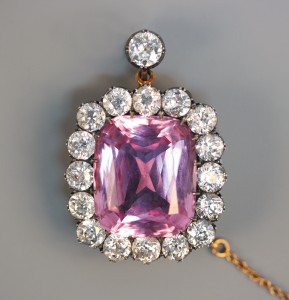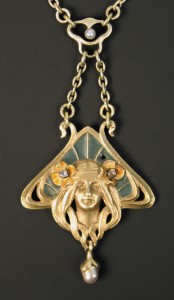
At the beginning of the 20th century, England had never been more prosperous. The English purchased more jewellery in the early years of this new century than in any other period in history.
The popularity of Art Nouveau and Revivalist jewellery continued in the spirit of the 1890s as people looked back to late 19th century tastes. The influence of the Arts and Crafts Movement was again felt as a demand for handcrafted jewels grew among this affluent society.
At its best, Edwardian jewellery interprets earlier styles with a lightness and delicacy of ornament and manufacture. The fashionable Edwardian lady wore her diamonds, pearls and precious gems with restraint, avoiding the Victorian tendency for ostentation. Restraint and exuberance marked out tastes in the light-hearted first decade of the century. Stones of intense, yet soft colours were favoured. Take, for example, the exquisite Edwardian jewel illustrated. This diamond and pink beryl pendant brooch, circa 1900, beautifully illustrates the appeal of an Edwardian Revivalist jewel. It measures 2cm x 1.7cm, this smaller size reflecting changes in women’s fashion. At the centre is the large pink beryl, claw-set in a surround of sixteen pinched collet-set, old-cut diamonds. The term ‘beryl’ covers a range of mineral-based stones, including emerald and aquamarine. The cut and setting of the diamonds also add to the air of restraint and softness of the piece. The pendant was owned by a continental lady, who had lived through the tumult of 20th century European history and had made her home in the heart of Sussex. At a recent specialist jewellery sale, its understated quality attracted the attention of contemporary connoisseurs of jewellery and it realised £15,500.

Less expensive examples from this period can still be found, like the Arts and Crafts-style bracelet in silver with blue/green enamelled rectangular and Celtic pierced-scroll panel links, also shown here. It was made in 1909 by Charles Horner, who manufactured this type of work in his Halifax factory in relatively large quantities, in response to fashion and demand. A bracelet like this would realise around £700 at auction today.

The gold, plique-à-jour enamel and rose diamond-set pendant illustrated is a delightful example of Art Nouveau design. It is decorated with the portrait of a maiden between two rose diamond-set flowerhead motifs above a cultured pearl drop. Plique-à-jour is a technique where enamel is applied to cells without backing; it gives the impression of miniature stained glass windows. The Art Nouveau seeks not to slavishly depict nature but rather to capture something of its essence. This appeal helped the pendant to realise £680 in spite of faults to the enamel.
All these pieces reflect the joy and light-heartedness of a new century, a punctuation mark in the procession of history before the tragedy of war and revolution broke upon Europe. The first decade of this new century was filled with expectation. The outbreak of the Great War in 1914 brought this extraordinary and particular period of patronage and manufacture to an abrupt close. Jewels were locked in security vaults or sold for survival.
Today this jewellery attracts attention and competition from across Britain and from around the world including the USA and, increasingly, China. Its quality of design, material and manufacture places it out of time and its continued appeal, it would seem, is as assured at the beginning of this new century as it was in the last.
Toovey’s specialist jewellery auctions can be viewed here.
By Revd. Rupert Toovey. Originally published on 1st May 2013 in the West Sussex Gazette.